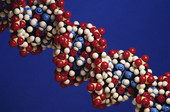
WEDNESDAY, July 27 (HealthDay News) — Researchers say they’ve identified the gene mutation that causes the same condition that Joseph Merrick, the 19th century Englishman famously known as “The Elephant Man,” was thought to have had.
Proteus syndrome causes different parts of the body to grow faster and larger than other parts. Only about 500 cases are known in the developed world.
The new findings, published in the July 27 edition of the New England Journal of Medicine, could help in the tricky diagnosis of this disorder (many of these patients are born normal), as well as eventually lead to treatments.
“This gives us a therapeutic target,” said study senior author Dr. Leslie Biesecker, chief of the genetic disease research branch at the U.S. National Human Genome Research Institute (NHGRI).
For people whose lives have been affected by Proteus syndrome, there is a deeper, more personal meaning in the new research.
“Understanding what we have here is huge for families,” said Kim Hoag, founder of the Proteus Syndrome Foundation, whose son, Alex, died from a pulmonary embolism, one complication of the disorder, at 9 years of age. “When you have a kid with Proteus syndrome, there’s no rhyme or reason to what he has. It’s so scary.”
Added Tracey Whitewood-Neal, chairwoman of the Proteus Syndrome Foundation UK and the mother of Jordan, a child with Proteus syndrome who is now 16 and preparing to enter college: “For me and other families, this is so much more than a scientific breakthrough. This is personal and this is real. This is the light at the end of the tunnel and the glimmer of hope we’ve been waiting for all these years.”
Proteus syndrome is what’s known as a mosaic disorder, meaning that some cells in the body have the hallmark genetic mutation and some don’t.
The mutation, which is genetic yet not inherited, occurs spontaneously some time after an embryo has already formed. This accounts for the great degree of variability in the condition, because the earlier the mutation occurs in embryonic development, the more widespread the overgrowth in tissue and bone.
According to the University of Kansas Medical Center, some of the common signs of Proteus syndrome include: partial enlargement of the hands and/or feet; overgrowth of one side of the face, body, or limbs; an enlarged head; discolored skin that can be rough; and tumors.
Although research on Proteus syndrome at NHGRI started in 1996, geneticists had to wait for the advent of next-generation gene sequencing to start testing tissue they had been banking over the years.
The researchers eventually were able to compare tissue samples from affected parts of the body in 29 Proteus syndrome patients with tissue from unaffected parts of the body.
Twenty-six of the patients had the exact same point mutation in the AKT1 gene. A point mutation is a single “misspelling” in the billions of letters that make up the human genome. The researchers hypothesized that the three patients who tested negative may have had low levels of the gene or had the gene in tissues that weren’t biopsied.
The good news is that the mutation also creates an oncogene, which can drive the uncontrolled cell division normally associated with cancer. Research is already under way to find drugs to battle that mutation as it occurs in tumors.
Treatments for Proteus syndrome may be able to piggy-back on these advances.
“It may become possible to treat those with Proteus syndrome with a drug originally developed for cancer,” Biesecker said at a Wednesday teleconference. “This allows us to leapfrog a number of steps. But, Proteus syndrome is not an overgrowth syndrome so we would have to adapt cancer treatments.”
The research team is now working with the Royal London Hospital, where Merrick died in 1890 at the age of 27, to test his skeleton for the mutation.
“We will answer the more than century-old question of the cause of his condition,” said Biesecker at the news conference. “It’s not an easy study because of the way the skeleton was degraded and prepared. We hope to be able to announce an answer in the coming months.”
More information
To learn more visit the Proteus Syndrome Foundation.

